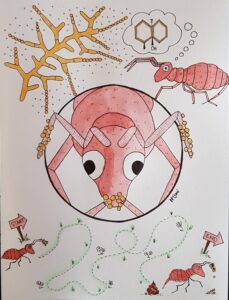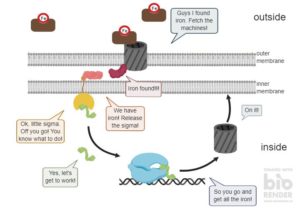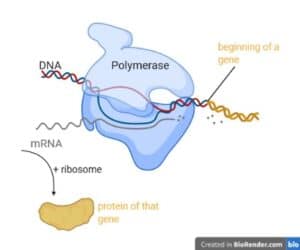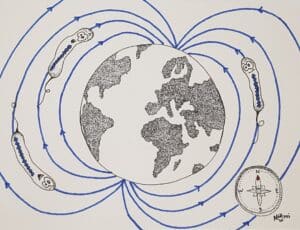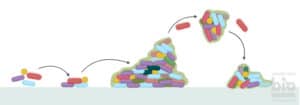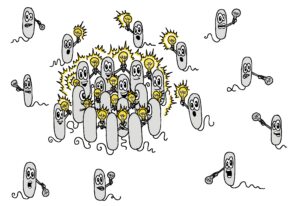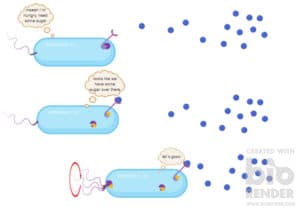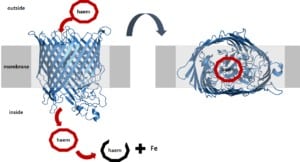Bacteria are social organisms. Just as us humans. Nobody wants to be alone and live on their own. Even as a bacterium, life is easier if you are with your friends and family and you can help each other or rely on others.
So, yes, also bacteria are always trying to find their siblings and communicate with them. And once they know they are not alone, they start reacting as a group.
Some bacteria start building biofilms – houses to keep the bacteria inside safe. Others like to talk to each other and produce goodies that everyone can enjoy. And other bacteria even form multicellular organisms with new superpowers.
Yet, some bacterial species like to move only in groups. Researchers call this bacterial movement twitching.
Bacteria can only twitch and move in groups when they have so-called twitching pili. Not all bacteria have these types of pili and – unfortunately for us – many bacterial pathogens produce them. And these bacteria use their pili to infect us and make us sick.
So, let’s have a look at what these bacterial pili are.
What are bacterial pili?
Bacterial pili look like little hair that grow out of bacterial cells.
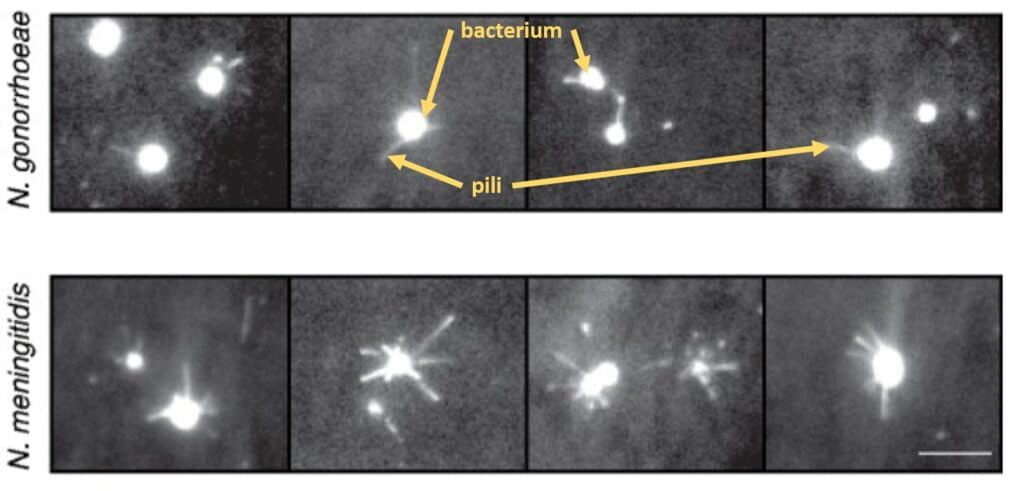
This hair is anchored to the bacterial cell envelope and can be attached to any site of the bacterial surface. Some bacteria only have on pilus, others have two pili at opposite ends and some bacteria even produce bundles of pili that work together.
The pilus hair is a helix of an endless number of the same protein: the so-called pilin protein. This pilin works like a perfect puzzle piece: Each end of the pilin fits the next pilin piece. Like this, endless pilin puzzle pieces attach to each other in a circular manner and form a stable hair-like helix structure.
But not to lose their precious hair, bacteria need to attach the pilus to their cell envelope. For this, bacteria have a huge anchoring complex on the inside of their cell envelope. And this anchor holds the pilus at the correct location.
To make this pilus dynamic, bacteria link the anchor to a tiny motor. This motor has a ring shape that surrounds the anchor and thus the hair. And bacteria need this motor for the actual moving process.
How do bacteria move with pili?
This circular motor on the inside of the cell envelope has two main functions: to extend and retract the pilus. Endless circles of extending the pilus, attaching to a surface and retracting the pilus allow bacteria to move.
To extend or lengthen the pilus hair, the motor (orange) binds the pilin proteins inside the bacterium (grey circles) and transports them outside of the cell. This costs energy, which is why bacteria need this little motor. Hence, by adding more pilin protein to the pilus from the inside, the pilus hair (grey) extends towards the outside.
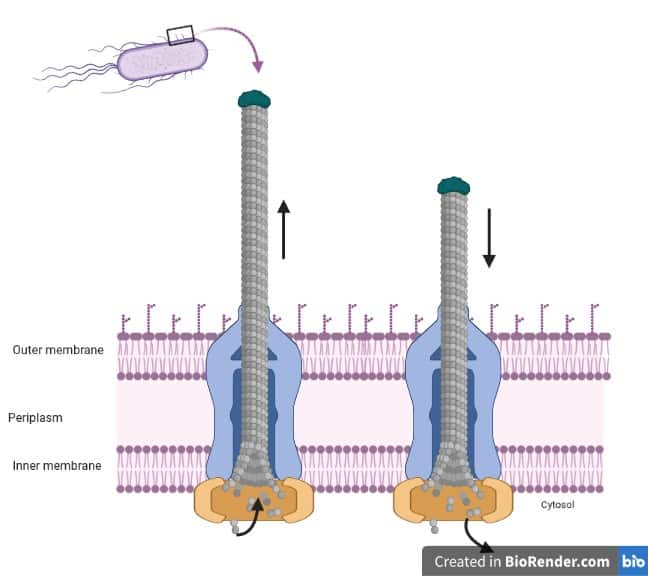
On the outside at the end of the pilus hair sits a protein (green) that can stick to surfaces. When this protein attaches to a surface, the motor on the inside of the bacterium changes its direction. Instead of adding pilins to the pilus and lengthening the hair, the motor takes pilins off the pilus and thus shortens the hair.
Now, the bacterium is attached to a surface while the pilus shortens. Like this, the bacterium pulls itself towards that surface.
This means that the attachment to the surface has to be so strong, that it can pull the bacterial cell towards this new location. This works like the bacterial superglue that some bacteria use to grow and survive.
What is the function of bacterial pili?
Bacterial pili can attach to all sorts of surfaces. Mainly, bacteria use this movement in environments of low water or on wet surfaces like human tissue.
For example, a bacterium can connect with its pilus to another bacterial cell. Now, when the bacterium retracts the pilus, it pulls the other bacterium closer. Like this, bacteria can form aggregates which helps them in the first steps of settling down and building biofilm houses.
Also, when several bacteria stick together and form bigger groups, they can move along a surface in a coordinated manner. This helps bacteria conquer new environments quicker and find new resources. For example, the bacterium Pseudomonas aeruginosa can reach out in swarms trying to find more space and new places to live in.
Interestingly, multicellular Myxobacteria move as huge cell aggregates to attack their prey. These bacteria use their twitching pili to glide along a surface, attach to a prey and pull the whole aggregate towards the prey. Like this, the Myxobacteria quickly run over their prey so it does not stand a chance.
However, bacterial pathogens also use pili to infect us. The bacterium Neisseria gonorrhoeae can attach its pilus to human epithelial and endothelial cells. When the bacterium then retracts the pilus, it pulls itself closer to the cell and attaches to it more tightly. Now, it can infect the cell and eventually the host.
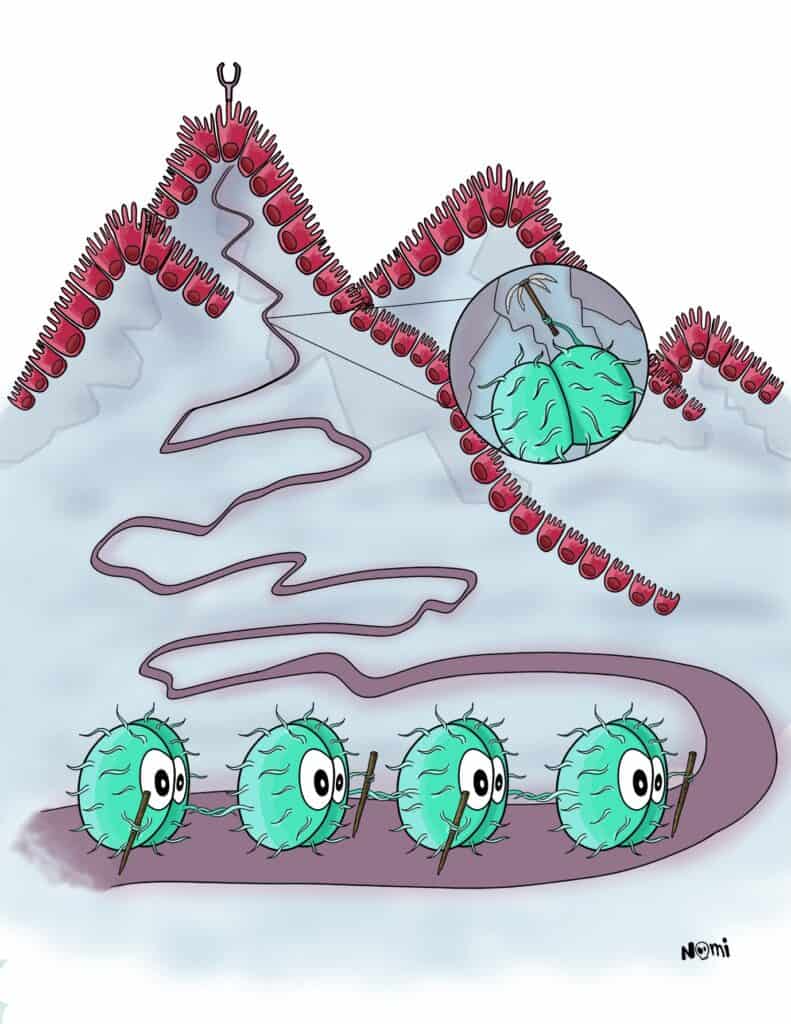
But not all is lost with bacteria and their pili. Currently, researchers are trying to better understand how bacteria use their pili and how this machine works mechanistically. They will then try to find drugs that inhibit the pili. This could be an alternative way to inhibit bacterial pathogens and maybe even drug-resistant bacteria.

